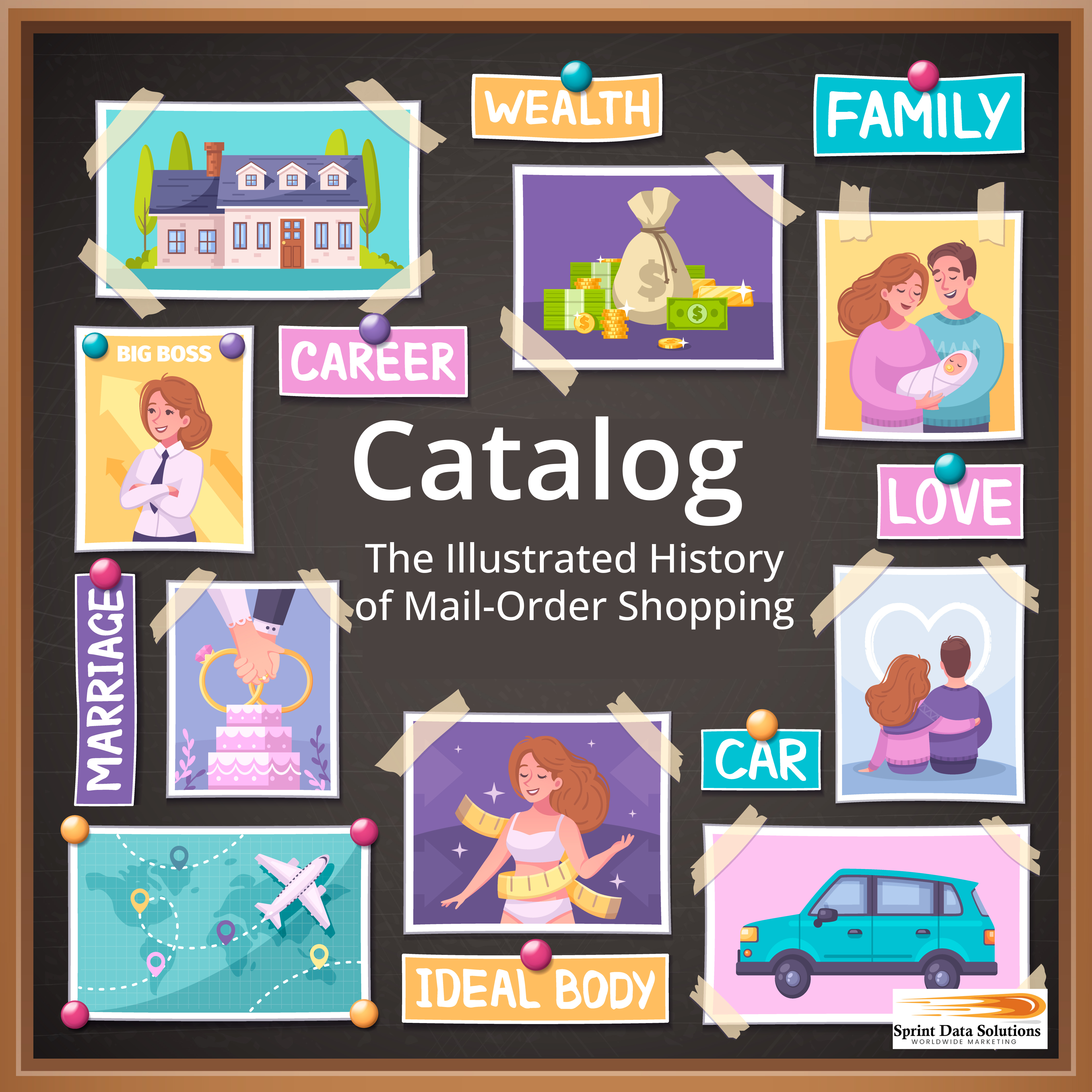Catalog & Magazine Mailing List
The 21st century has ushered in numerous changes in the way we approach traditional activities, particularly shopping. In the past, Americans would routinely visit physical locations like markets, department stores, or shopping malls to make their purchases. This was a staple of consumer behavior for generations. Today, however, the landscape has shifted dramatically, with the digital revolution offering the convenience of online shopping. E-commerce platforms now allow people to browse and purchase products from the comfort of their own homes, at any time of day or night. Despite this rapid technological transformation, one aspect of traditional marketing still maintains its relevance: the catalog.
The catalog, once the primary method of showcasing goods, has adapted to the times but remains a significant force in marketing. Although it originated as a print-based medium, catalogs have evolved in digital formats, blending the traditional with the modern. Catalogs remain a crucial tool for both direct mail marketing and digital marketing strategies, continuing to influence consumer purchasing behavior. In fact, many online retailers still use digital catalogs to complement their websites, offering a more curated shopping experience that guides potential customers through their product selections.
This format, while considered vintage in some respects, has endured because it provides a tactile and visually appealing way for customers to explore products, whether through glossy printed pages or interactive digital versions. Catalogs and similar print materials, such as flyers and brochures, offer distinct advantages: they allow businesses to create well-organized, visually attractive presentations of their offerings that can be carefully curated and targeted. For certain segments of the population, particularly older generations, the experience of flipping through a catalog remains a preferred way to shop, allowing businesses to tap into these traditional consumer habits.
Even in an era dominated by online research, the catalog has managed to stay relevant. By combining it with other traditional media like magazines, companies continue to engage with their audience in a personal and immersive way, drawing on the nostalgia and tactile engagement these formats offer. At Sprint Data Solutions Worldwide Marketing, we recognize the enduring power of these traditional marketing methods and work with businesses to target the catalog- and magazine-consuming demographic. Through our expertise in data acquisition, management, and segmentation, we can help businesses identify the right audience and deliver catalog and magazine-based marketing campaigns that capture attention, drive engagement, and generate sales.
The Sprint Data Solutions Worldwide Marketing Story
Sprint Data Solutions Worldwide Marketing is a fully American-owned and operated business, founded by a disabled veteran with a commitment to shifting from defense to economic empowerment. After fulfilling the obligations of military service, the founder chose to dedicate their efforts to fostering growth within the American business community. The vision was clear: to create a business that would not only thrive but also help other businesses expand by leveraging the power of data. This vision led to the birth of Sprint Data Solutions Worldwide Marketing, which began operations in Las Vegas, Nevada, and quickly gained a reputation for its high-quality services and reliable results.
Over the years, the company has steadily grown, building a solid foundation of trust and delivering exceptional service to clients across a wide range of industries. With an unwavering focus on customer success, Sprint Data Solutions Worldwide Marketing has expanded its offerings to include a comprehensive suite of marketing services. These services range from advanced data analytics and lead generation to full-service direct mail and email marketing solutions.
Today, the company boasts a highly skilled team with over 50 years of combined experience in marketing, sales, and data management. The dedicated professionals at Sprint Data Solutions Worldwide Marketing have helped businesses, both large and small, tap into the full potential of their marketing strategies by providing access to the most current, relevant, and targeted contact data available. The company’s continuous dedication to innovation and customer-centric solutions has positioned it as a leader in the marketing industry, and it remains committed to supporting American businesses in their growth and success.
When Sprint Data Solutions Worldwide Marketing first began its operations, the marketing landscape was largely dominated by traditional, analog platforms such as print media, television, and radio. These channels were the go-to methods for reaching consumers, and the marketing industry primarily relied on these tried-and-true methods. Sprint Data Solutions Worldwide, however, chose to focus on one particular avenue within this traditional realm: direct mail marketing. This specialization quickly set the company apart, positioning it as a leader in the direct mail industry. The company’s ability to craft compelling and targeted direct mail campaigns helped it secure long-term success in a field that remained effective even as the years passed and technology advanced.
As the business grew, Sprint Data Solutions Worldwide expanded its service areas in response to rising demand. Initially focused on Las Vegas, Nevada, the company’s reach quickly extended to encompass the entire state, setting the foundation for future growth. From there, it spread across the continental United States, incorporating every state, including Alaska and Hawaii, and continued to build a reputation for excellence in direct mail services. The company’s expansion didn’t stop at national borders; it extended its services to international markets as well. With a strategic focus on accessibility, Sprint Data Solutions Worldwide Marketing expanded to Mexico and Canada, providing clients with direct access to North American markets.
Recognizing the growing influence of the digital age, Sprint Data Solutions Worldwide adapted its services to meet the needs of this evolving landscape. While direct mail remained a cornerstone of the company’s offerings, it began offering digital marketing services to meet the demands of an increasingly computer-driven world. As businesses and consumers alike embraced the internet, Sprint Data Solutions Worldwide quickly integrated online marketing strategies, tapping into the power of digital platforms like email, social media, and search engine marketing to provide a comprehensive suite of services for its clients.
In time, Sprint Data Solutions Worldwide grew its scope further, expanding its international reach into Europe, with specific services targeting markets in the European Union, such as France. Today, Sprint Data Solutions Worldwide Marketing not only continues to excel in direct mail but also stands as a fully integrated marketing solutions provider, offering clients a blend of traditional and digital marketing strategies to cater to the diverse and dynamic needs of the modern marketplace. This seamless integration of old and new technologies has positioned the company as a forward-thinking leader in both analog and digital marketing arenas, ensuring its clients continue to thrive in a fast-changing world.

The Catalog & Magazine Advantage
Despite the overwhelming rise of digital marketing and online shopping platforms, catalogs and magazines remain surprisingly relevant and even desirable in today’s fast-paced, tech-centric world. There’s a unique charm that comes with flipping through the glossy pages of a well-crafted catalog or magazine. These physical items offer a sensory experience that no website or email can replicate – the feel of the paper, the rich colors, and the carefully curated design elements that capture the attention in a way a digital screen often can’t. They represent a tangible connection between a business and its customers, one that feels personal and direct.
The effectiveness of catalogs and magazines is particularly evident in their ability to target specific audiences without relying on an internet connection. Unlike digital content, which requires access to a device and an active internet connection, these print materials can be enjoyed anytime, anywhere – from a cozy living room to a quiet café or even while commuting. This lack of reliance on technology makes catalogs and magazines highly accessible to those who may not be as digitally connected or prefer a more tactile method of shopping and learning about new products.
Moreover, when produced with care, catalogs and magazines stand apart from the often generic and rushed nature of online content. The editorial team behind a high-quality catalog or magazine often invests considerable time and effort into crafting engaging stories, detailed product descriptions, and visually appealing layouts. This level of attention to detail can create a stronger emotional connection with the reader compared to quickly assembled websites or digital advertisements. For businesses, this offers a unique opportunity to stand out in an era where digital content is often overlooked or ignored by consumers bombarded with emails, pop-up ads, and banner advertisements.
Catalogs, in particular, have evolved to complement the digital shopping experience. Businesses have found innovative ways to bridge the gap between the physical catalog and online purchasing. QR codes, personalized URLs, and even phone numbers strategically placed within catalogs encourage readers to seamlessly transition from the print experience to a digital or phone-based transaction. This fusion of old and new technology allows businesses to offer a multi-channel approach, tapping into both the nostalgic appeal of catalogs and the convenience of modern online ordering.
Magazines, similarly, allow businesses to create a lasting impression, whether through eye-catching covers or carefully curated editorial content that speaks to a niche market. Magazines often find a home in the hands of consumers who value high-quality writing, in-depth features, and specialized content that caters to their interests. This makes them an ideal marketing tool for businesses in fields like fashion, luxury goods, wellness, and travel, where image and brand identity play a crucial role in the purchasing decision.
Catalogs and magazines, when used strategically, allow businesses to bypass crowded email inboxes and create a memorable, tangible experience for their customers. By combining the best aspects of both physical and digital marketing, they enable companies to connect with their audience in a way that feels personal, curated, and immersive – an experience that online platforms sometimes struggle to deliver.
Home Cooking Magazines
The pandemic brought about significant shifts in how people approached dining habits, including a notable decrease in the frequency of eating out at restaurants. Even as the pandemic recedes, many individuals have maintained a preference for cooking at home, viewing it as a more budget-friendly option in the long run. This shift is partly driven by the desire to manage household expenses more effectively, with cooking at home offering the opportunity to prepare larger meals at a fraction of the cost of dining out. Additionally, home cooking allows individuals to have greater control over the ingredients, portion sizes, and nutritional content of their meals, which further appeals to those looking for healthier, more personalized options. Cooking magazines, in this context, have gained renewed relevance. Not only do they provide a wealth of recipes that cater to diverse tastes and skill levels, but they also offer a tangible, safe alternative to digital devices in the kitchen. Unlike smartphones or tablets, which can be prone to spills, smudges, and distractions, cooking magazines are durable and easy to handle, allowing cooks to focus entirely on the task at hand. With clear, easy-to-follow instructions and beautiful imagery, they remain a trusted tool for anyone looking to explore new culinary horizons without the risk of digital interference.
Fine Wines
Wine is much more than a beverage; it is an art, a passion, and for some, a valuable investment. For centuries, wine has been intricately woven into the fabric of cultures around the world, evolving from a daily staple to an experience of sophisticated indulgence. Whether it’s a simple, everyday table wine or an exclusive, limited-edition bottle from a renowned vineyard, wine holds a unique place in the lives of enthusiasts, collectors, and casual drinkers alike. Its diverse range offers something for everyone, from affordable bottles that enhance a meal to prestigious vintages sought after for their investment potential.
Wine magazines and catalogs continue to play an essential role in cultivating and nurturing this passionate community. These publications are more than just marketing tools—they provide valuable knowledge, educational content, and insight into the deep culture and history of wine. Content must go beyond basic product listings; it should educate readers about wine regions, varietals, terroir, and winemaking processes. For true wine lovers, understanding the nuances of production, aging, and the delicate balance between vineyard conditions and wine quality is crucial.
Marketing wine isn’t a one-size-fits-all endeavor; it spans a wide spectrum, catering to various consumer segments. From the casual consumer looking for an affordable, yet delightful bottle to the connoisseur in pursuit of the perfect vintage, marketers must tailor their approach to reflect these diverse tastes and purchasing motivations. Wines may be classified into several categories: approachable everyday wines for regular consumption, high-end premium wines from award-winning estates, and exclusive, celebratory bottles such as ice wines, which are often reserved for marking special events and milestones.
Wine’s cultural significance, rich heritage, and place in society make it a subject of perpetual interest. Wine magazines, therefore, have the unique opportunity to blend education with marketing. Articles that explore the latest trends, profiles of emerging vineyards, or deep dives into wine’s historical significance help connect readers to the broader world of wine. Additionally, with the rise of e-commerce and digital platforms, wine marketers must balance traditional print media with engaging, interactive online content, offering both a comprehensive understanding of wines and an opportunity for collectors to make informed purchasing decisions.
As the wine industry continues to evolve, marketing efforts must adapt. Digital content must reflect the values of sustainability, craftsmanship, and authenticity that today’s wine drinkers prioritize. Highlighting trends such as organic and biodynamic wines, sustainable vineyard practices, and the integration of technology in winemaking will appeal to modern consumers who seek both luxury and responsibility in their choices.

Cigars
Cigars, much like wine, have long been regarded as a premium leisure item, often associated with luxury and indulgence. Their consumption is frequently linked to social occasions, special celebrations, or moments of personal relaxation, making them more than just a product but an experience. The passion for cigars spans centuries, transcending generations and cultures, with a rich history that dates back to the indigenous peoples of the Americas. While modern medical warnings may cloud their appeal, the enjoyment of cigars remains a cherished tradition for many. Unlike cigarettes, which are typically consumed daily, cigars are smoked less frequently, often in a more ceremonial or leisurely context. This makes each cigar more of a deliberate, mindful indulgence, something to savor and appreciate.
Like wine, cigars are consumable, meaning once a supply is exhausted, there is a natural need for replenishment, whether for daily enjoyment or for more special occasions. Furthermore, just as wine enthusiasts enjoy experimenting with different varieties, cigar aficionados also seek to explore new blends, brands, and regions of origin. The world of cigars offers a wide range of choices, from mild and aromatic to full-bodied and robust, allowing for personal preference to play a central role in the selection process.
Effective marketing and presentation play a key role in targeting the right audience, and educating consumers about the nuances of different cigars can lead to enhanced appreciation and sales. Providing in-depth information about a cigar’s origin, flavor profile, aging process, and the craftsmanship behind it can cultivate a deeper connection between the consumer and the product. When marketing cigars, it’s important to highlight these qualities, crafting a narrative around each product that appeals to both seasoned enthusiasts and newcomers alike. Whether through events, tastings, or informative content, positioning cigars as more than just a product but as part of a lifestyle and experience can yield great results when directed at the right market.
Household Goods
Homes are complex environments that demand a wide array of products and services to function seamlessly. From everyday essentials like dish soap and toilet paper to seasonal necessities such as sidewalk salt for winter, each room in the house has its own set of required items. Catalogs serve as a comprehensive resource, offering an extensive selection of these products—whether they are cleaning supplies, kitchen tools, or home decor items. They provide a one-stop shop for homeowners looking to stock their homes with the right materials and solutions. Meanwhile, magazines are invaluable for offering expert advice on how to maintain and improve a home. They not only showcase the best products available, but also provide in-depth reviews, tips, and techniques for maximizing home efficiency. These publications offer a mix of inspiration and practical guidance, helping homeowners make informed choices and implement the best practices for keeping their homes clean, organized, and functional throughout the year.
Children’s Products
The market for children’s products has consistently been a robust and expansive sector, encompassing a wide range of categories such as educational tools, nutritional supplements, entertainment, clothing, and toys. This diversity in offerings reflects the growing needs and expectations of both children and their parents. Catalogs designed for children’s products can be just as varied, often tailored to meet the demands of different age groups, interests, and developmental stages. However, children’s magazines have emerged as a powerful tool in this market, offering a unique and effective platform for reaching parents. These magazines serve as an invaluable resource for parents looking for the latest innovations in child care, education, and entertainment, providing fresh ideas and practical solutions to enhance the child-rearing experience. Magazines can engage parents by offering expert advice, product recommendations, and creative activities, helping parents stay informed and confident in the choices they make for their children’s development and well-being. With their targeted content and credibility, children’s magazines often inspire trust and loyalty, making them an ideal channel for promoting a wide variety of children’s products.
CBD Oil & CBD Creams
As states across the United States continue to evolve their legal frameworks surrounding cannabis, cannabidiol (CBD), a non-intoxicating by-product of cannabis, has quickly gained recognition as an effective remedy for a variety of health issues. This includes managing stress, alleviating pain, and addressing digestive problems in both humans and animals. Unlike tetrahydrocannabinol (THC), the active ingredient in cannabis responsible for the “high,” CBD oil does not produce intoxicating effects, making it suitable for a wide array of applications. Consequently, CBD products are increasingly utilized in the wellness and healthcare sectors, where their versatility is embraced.
Given the growing popularity and diverse uses of CBD oil, it is crucial to tailor marketing strategies to the unique needs and preferences of different consumer segments. For instance, seniors have become a key demographic, utilizing CBD oil as a natural alternative to traditional pain medications. This age group often seeks non-psychoactive treatments for chronic conditions such as arthritis, joint pain, and muscle soreness. In contrast, athletes tend to favor topical CBD products such as creams and balms, which provide targeted relief for sore muscles and injuries sustained during physical activities. These distinct customer groups require specialized marketing approaches that highlight the specific benefits of CBD products suited to their respective lifestyles.
Effective marketing of CBD-based products, therefore, must focus on clear communication of the product’s advantages, emphasizing its natural, non-intoxicating properties. Magazine and catalog content can serve as powerful vehicles to reach these diverse audiences, providing detailed product information, customer testimonials, and educational articles that resonate with each group’s unique needs. As the demand for CBD oil and related products continues to rise, understanding the nuances of each target demographic will be essential to crafting compelling campaigns that engage and convert potential customers.
Sports Magazines & Products
Sports magazines have long been a cornerstone of sports culture, offering in-depth coverage of both widely popular and niche sports. From the roaring crowds of basketball arenas to the quiet intensity of bobsledding tracks, the demand for detailed insights into sporting events, athletes’ careers, and technical aspects of each sport remains ever-present. Fans crave analysis, statistics, behind-the-scenes stories, and expert commentary, making sports publications a crucial tool for deepening their connection with the games and athletes they follow.
Equally, the need for sporting products is an ongoing and ever-evolving aspect of the sports industry. Magazines dedicated to sporting goods and product catalogs serve as essential resources for enthusiasts, from amateurs to professionals, helping them find the equipment that best suits their needs. Whether it’s new basketball shoes, cutting-edge fitness gadgets, or specialized gear for more niche sports like bobsledding or archery, these magazines and catalogs provide a valuable bridge between consumers and the brands that cater to their interests. For marketers, understanding how to align the right product offerings with the correct audience—whether targeting athletes, coaches, or fans of a specific sport—is critical to successfully reaching potential customers.
Ultimately, the sports publication and product markets are interconnected, with both relying on a deep understanding of consumer preferences. It’s not just about offering a product or magazine; it’s about offering the right content or gear that resonates with the specific interests, aspirations, and needs of the audience, fostering a lasting connection that extends beyond the game. The continuous evolution of both sports content and the products supporting them ensures that both enthusiasts and businesses remain engaged in a dynamic, ongoing conversation.
Seeds & Plants
Gardening has long been a cherished activity for many American households, fostering a connection with nature and offering an outlet for creativity. In recent years, however, gardening has experienced a resurgence in popularity, driven by growing environmental awareness, the increasing desire for self-sufficiency, and the financial benefits of growing one’s own food. With more people looking to create sustainable, green spaces and reduce their carbon footprints, gardening has evolved into a multifaceted hobby that caters to individuals at all skill levels.
From beginner gardeners eager to cultivate their first tomato plant to seasoned hobbyists seeking specialized seeds, unique plants, or advanced gardening tools, the gardening market has expanded to meet diverse needs. For newcomers, there are numerous products designed to simplify the gardening process, such as starter kits, beginner-friendly plant varieties, and educational resources that teach essential gardening techniques. For those with more experience, the market offers a range of high-quality, hard-to-find seeds, premium soil amendments, and expert-level products designed to elevate their gardening practices, whether it’s through vertical farming, hydroponics, or organic pest control.
Additionally, many people are drawn to the idea of growing their own food as a means of saving money, reducing reliance on store-bought produce, and contributing to a healthier lifestyle. In response, there has been an increase in demand for home gardening products such as raised garden beds, composting bins, heirloom seed varieties, and eco-friendly gardening tools. Furthermore, gardening services, like landscape design and garden maintenance, are being offered to help those who want to make the most of their green spaces without investing too much time or expertise.
Ultimately, gardening has become more than just a pastime; it’s a lifestyle choice that reflects a growing commitment to sustainability, environmental stewardship, and personal well-being. The range of products and services available today ensures that both novices and seasoned gardeners can cultivate beautiful and productive gardens, whether in their backyards or small urban spaces.
Collectibles
The collectibles market is incredibly diverse, with a vast and highly engaged consumer demographic, but the interests and purchasing habits within this segment are far from uniform. Collectors are highly specific about the types of items they pursue, and these preferences can vary dramatically. For instance, a stamp collector is drawn to the history, rarity, and condition of stamps, appreciating their value from a historical and artistic perspective. This interest is worlds apart from that of a vinyl enthusiast, who seeks to amass a collection of both new and vintage music pressings. For vinyl collectors, the experience is largely sensory, driven by the tactile nature of records, the nostalgia of older pressings, and the hunt for rare or limited editions that evoke specific memories of eras past. On the other hand, the world of retro gamers is focused on hardware and software from the 1980s and 1990s, with collectors often seeking out vintage consoles, video games, and accessories. Their interest is rooted in nostalgia, the thrill of restoring old hardware, and the pursuit of hard-to-find games that represent milestones in the evolution of gaming.
Given these stark differences, it’s essential that catalogs and magazines aimed at collectors strive for precision and specificity. A stamp catalog, for example, would hold little to no appeal for a retro gamer, whose focus is entirely on video game-related memorabilia. Similarly, a magazine dedicated to retro gaming would miss the mark with a vinyl collector, whose interests lie in music rather than gaming culture. However, when marketing materials are tailored to meet the specific needs of the right collector, the results are profound. There’s a high level of engagement, interest, and response when collectors encounter material that speaks directly to their passions, whether it’s stamps, vinyl, retro games, or any other collectible niche. The success of marketing to these distinct subgroups depends entirely on understanding the nuances of their interests and crafting specialized content that resonates with their unique collecting pursuits. Targeting the right audience with the right message not only increases the likelihood of a sale but also fosters brand loyalty, as collectors recognize that businesses truly understand and cater to their specific needs.

Clothing & Fashion
Clothing has long been a cornerstone of catalog sales, maintaining its status as a major driver in both traditional and online retail markets. It remains one of the most consistently sought-after categories for Sprint Data Catalog Mail Order buyers, as well as RESPONDERS with an affinity for shopping. The diversity of clothing purchases, however, is a reflection of the wide array of consumer interests and needs. While fashion remains a key factor, clothing choices are often dictated by practicality, lifestyle, and the specific requirements of different customer segments. For instance, professional attire is valued not only for its aesthetic appeal but also for its durability, comfort, and the protective qualities it offers in various work environments.
The evolution of online shopping has further underscored the importance of high-quality imagery in showcasing clothing. The effectiveness of catalogs and magazines in selling apparel depends heavily on the visual presentation. High-resolution images, coupled with compelling storytelling that highlights the functionality, versatility, and style of the garments, can significantly enhance consumer engagement. Clothing that is presented with clarity and elegance—whether it is workwear designed for durability or the latest fashion trends—captures the attention of shoppers and helps them visualize the value in the product.
Additionally, with the rise of lifestyle-focused content, consumers are increasingly looking for clothing that aligns with their personal brand, values, and everyday needs. Fashion content that underscores how a piece fits into a broader lifestyle narrative, whether it’s for professional success, outdoor adventures, or casual elegance, becomes a powerful tool in influencing purchase decisions. Clothing that offers both utility and style resonates with buyers who appreciate functionality alongside aesthetics, further ensuring its ongoing success in catalogs and magazines.
Thus, the consistent appeal of clothing in both print and digital sales channels is not just about the item itself but how it is communicated. The right images paired with a solid understanding of consumer desires and the application of effective visual storytelling make clothing an enduring and lucrative category for catalog and online sales.
Home Improvement
Home improvement and renovation projects, when managed by professionals, can lead to outstanding results, enhancing the overall value and functionality of a home. However, these services often come at a high cost, which is why many homeowners turn to “Do It Yourself” (DIY) alternatives. DIY home improvement remains a highly popular and cost-effective choice for many, allowing individuals to tackle smaller projects on their own while saving money. This trend presents a valuable opportunity for businesses within the home improvement sector, particularly those offering products and tools that facilitate DIY projects.
For businesses offering home improvement products, reaching out directly to consumers can prove to be extremely profitable, especially when the marketing strategy is well-targeted and appeals to the motivations behind DIY efforts. Homeowners constantly encounter areas in their homes that require attention, whether it’s minor repairs, necessary upgrades, or more extensive remodeling endeavors. Even smaller renovations, such as updating a bathroom, installing new flooring, or repainting a room, can make a significant difference in a property’s appeal and resale value.
In addition to the everyday repairs, more ambitious home improvement projects—like remodeling kitchens, adding new bathrooms, or even foundational repairs—have grown in popularity. As people continue to invest in their homes, the home improvement industry has seen rapid growth, with a wide variety of projects ranging from aesthetic changes to functional upgrades. Within this booming industry, there is abundant space for businesses to thrive, particularly those focusing on areas like kitchen renovations, home additions, or specialized repair services.
For businesses in this field, it’s crucial to understand the diverse needs of homeowners and offer products or services that cater to both DIY enthusiasts and those seeking professional help. Marketing efforts must address the unique needs of different consumer segments, whether they’re looking for DIY supplies, professional contractors, or a combination of both. By reaching these consumers at the right time with the right message, businesses can establish strong relationships and tap into the ongoing demand for home improvements.
Precision Marketing
The key to success with catalog, magazine, or other forms of traditional print marketing lies in understanding and optimizing response rates. While it’s a common misconception that a 100% response rate is attainable, this is simply not the case. Even the most eye-catching and well-crafted marketing efforts will not lead to universal engagement. However, businesses can take strategic steps to increase their likelihood of generating responses and avoid the pitfall of being ignored.
A critical element of effective marketing is to avoid a blanket approach that targets a broad audience with no consideration for relevancy. For instance, sending catalogs to hundreds of thousands of individuals, simply because they are on a purchased mailing list, may not yield favorable results. This approach is akin to casting a wide net in hopes of catching a few fish, but the majority will slip through. Take, for example, a catalog offering children’s toys. If the mailing list includes a significant portion of recipients who have no children, such as college students, the chances of generating sales will be inherently low. The mismatch between the product and the recipients’ needs results in wasted resources and missed opportunities.
The power of precision marketing cannot be overstated. A better approach is to identify and target specific segments that are most likely to respond. If a catalog features products aimed at families with young children, targeting a list of parents with children between the ages of 2-10 will significantly improve the chances of engagement. While this means a smaller, more targeted mailing list of a few thousand recipients, the response rate will likely be much higher than marketing to a broader, less relevant audience. This strategy may seem counter-intuitive because it involves reaching fewer people, but in fact, reaching a highly interested, qualified audience will yield far greater returns.
The crux of the matter is that precision trumps generality. By narrowing down the audience to those with a genuine interest or need for the product, businesses can engage recipients who are more likely to take action. This approach leads to higher conversion rates, increased sales, and more meaningful customer relationships. Instead of casting a wide, indiscriminate net, businesses should focus on precision, ensuring that their marketing materials reach the right individuals at the right time. By doing so, they maximize their marketing ROI and increase the likelihood of a successful campaign.
We’re Here To Help
Over the years, Sprint Data Solutions Worldwide Marketing has meticulously curated one of the largest and most comprehensive databases in the industry, catering to a wide array of consumer and business-to-business (B2B) needs. Their commitment goes beyond simply collecting contact information—they prioritize the accuracy and relevancy of the data, ensuring that every piece of information is continuously updated to reflect the most current status. This diligence helps mitigate inefficiencies, such as sending marketing materials to individuals who have passed away or targeting specialized enthusiasts who no longer reside at a specific address. By maintaining high-quality, up-to-date records, Sprint Data Solutions ensures that its clients reach their intended audience effectively.
As technology evolves, so does the landscape of communication. Sprint Data Solutions Worldwide Marketing is fully equipped to accommodate this shift, offering a diverse range of contact details that extend far beyond traditional physical mailing addresses. In today’s fast-paced, multi-channel world, marketing strategies must incorporate a variety of communication methods to engage consumers where they are most active. This includes not only phone numbers for voice calls but also email addresses for email marketing campaigns, and even cellular phone numbers for text/SMS messaging, which have become vital in reaching consumers directly and efficiently. By staying ahead of these changes, Sprint Data Solutions Worldwide Marketing ensures its clients are able to tap into the full spectrum of modern marketing channels, enhancing the potential for engagement and boosting response rates.
Find The Right List For You
Sprint Data Solutions Worldwide Marketing offers a comprehensive range of mailing lists tailored to businesses in need of catalog and magazine buyers, mail-order buyers, and catalog shoppers. Our vast collection of data spans a variety of categories, meticulously organized to meet the unique demands of both consumer and B2B marketing campaigns. Whether you’re targeting general consumers or niche markets, our breakdowns are designed for maximum precision and segmentation.
Geographically, our data is incredibly flexible, allowing businesses to scale their marketing efforts based on their specific goals. You can start with a broad, nationwide approach or narrow your focus to a specific region, such as targeting catalog buyers in New England. Our lists also allow for hyper-targeting, whether you’re looking to reach a particular state, city, or even a single neighborhood. This level of granularity ensures that businesses can craft hyper-localized campaigns to effectively engage their target audience.
Additionally, our databases go beyond simple location-based filters by incorporating a wide array of demographic and psychographic attributes. These databases are not only segmented by basic factors like age, income, or purchasing behavior but also include more sophisticated metrics such as lifestyle, interests, and buying patterns. To maintain relevance and value, every piece of data is rigorously evaluated and updated on an ongoing basis. This commitment to accuracy ensures that you are always working with the most up-to-date and actionable information available, helping you target the right people with the right message at the right time. Sprint Data Worldwide Marketing uses a broad range of different characteristics for profiles, such as:
- Age
- Ethnicity
- Debt
- Age of Children
- Renter
- Homeowner
- Income
- Marital Status
- Mortgage Data
- Geography
- Veteran Status
- Big & Tall Mail Order Buyers
At Sprint Data Solutions Worldwide Marketing, we understand the importance of reaching the right audience with precision. Whether you’re looking to target a broad consumer base or a very specific group, we provide customizable catalog and magazine direct mail lists tailored to your campaign’s needs. Our extensive database encompasses a wide range of demographics, interests, and behaviors, ensuring that your catalogs and magazines reach individuals who are most likely to engage with your content. With advanced targeting capabilities and data analytics, we help businesses maximize their marketing efforts by delivering their materials directly to responsive customers. Let us assist you in generating leads that convert, ensuring your direct mail campaign stands out and delivers results. Trust Sprint Data Solutions Worldwide Marketing for a reliable, results-driven approach to catalog and magazine distribution.






